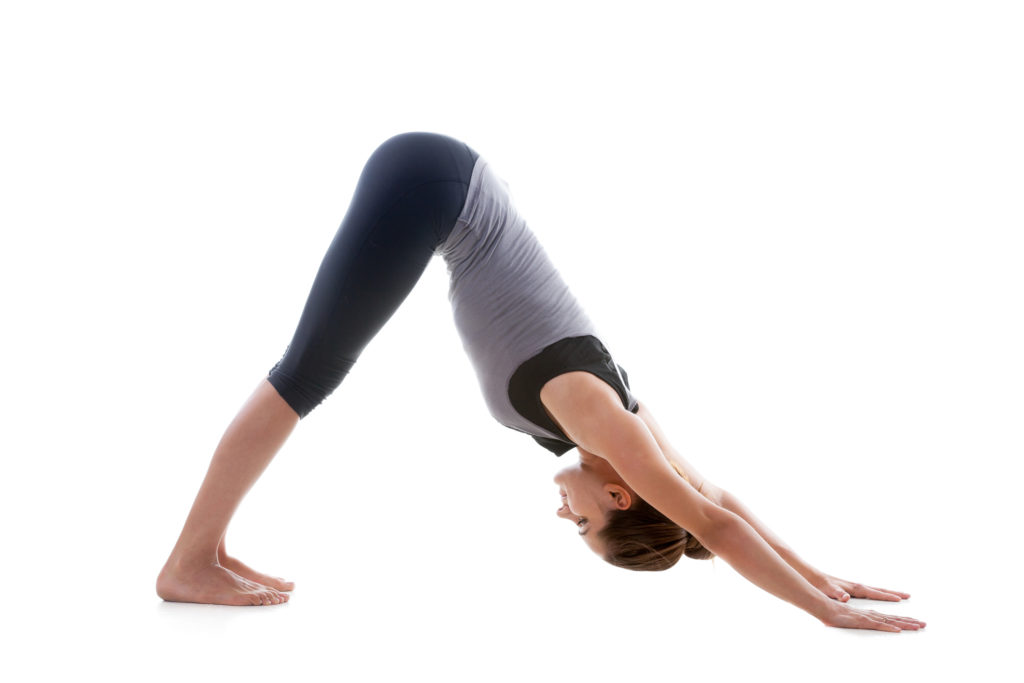DOWNWARD FACING DOG POSE
Adho Mukha Svānāsana
(AH-doh MOO-kah shvah-NAHS-anna)
Adho = downward
Mukha = face
Svana = dog

Steps:
- Lie face down on the floor. Take the feet about 4 inches apart. Bend the elbows and place the hands beside the rib cage. Open the palms and spread the fingers, with the middle fingers pointing forward. Keep the hands in line with each other and also in line with the feet. This is the base of the posture.
- Tuck the toes under, raise the head and trunk; bend the legs to raise the hips. Straighten the arms. Check alignment of feet and hands. This will bring you into table position on the floor. Hands are shoulder width apart with the hands directly below the shoulders, fingers spread in “star hand” (middle finger pointed forward) and press the palms firmly into the floor. Stretch the thumbs and see if you can get them to point towards each other.
- Knees are directly under the hips, curl the toes under and on the inhale bend the knees and push the buttocks to the ceiling, on the exhale push your weight back over the legs straightening out the arms. Draw the biceps and triceps into the bones of the arms.
- Continue to push your weight back onto the legs as you lower your heels towards the floor. Back should be as neutral position as possible and neck relaxed. Lift the kneecaps and tighten the quadriceps, stretching through the hamstrings. Then relax the legs.
- Check the hands one more time to make sure that even pressure is placed across the entire hand. Open through the chest and allow the shoulder blades to lower down the back. Move and stretch in your pose…do not stay stagnant.
- Keep the weight even on both hands and both feet. Move the dorsal spine and kidneys in. From the diaphragm stretch the abdomen up and the chest down. You can lift the toes which will bring you onto the balls of your feet. Draw the heel back as if to stretch the bottom of the foot longer.
- Stay here for a few breaths and then lower to the knees and into balasana.
Modifications & props:
You can bind the upper arms with a strap right above the elbows. Push the inner shoulder blades outward against the resistance of the strap.
Variations:
If you wish, you can lift the right leg. Dorsi flex the foot, pushing out through the heel and pointing the toes towards the floor. (Keeping the hips square and the ball of the ball and socket joint pressed into the socket). You could take this one-step further by opening up the hip and plantar flexing the foot (or pointing the toes), lifting the leg as high as you can get it. Keep the shoulders square to the front of your mat. Stay a couple of breaths and bring leg down. Repeat with the left leg.
Benefits:
Calms the brain and helps relieve stress and mild depression; removes fatigue and brings back lost energy; develops lightness in the legs; relieves pain and stiffness in heels and helps to soften calcaneal spurs; stretches the hamstrings, calves, arches, hands and shoulders; strengthens the arms, legs, and ankles; arthritis of the shoulder joints is relieved; abdominal muscles are drawn towards the spine and strengthened; as the diaphragm is lifted to the chest cavity the rate of the heart beat is slowed down; helps relieve the symptoms of menopause; relieves menstrual discomfort when done with head supported; helps prevent osteoporosis; improves digestion; relieves headache, insomnia, back pain and fatigue; therapeutic for high blood pressure, asthma and flat feet, and sciatica.
Contraindications:
Wrist or hand injury/carpal tunnel; diarrhea; pregnancy in the last semester; headache.
